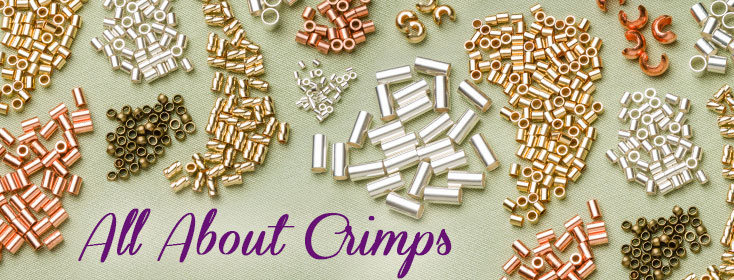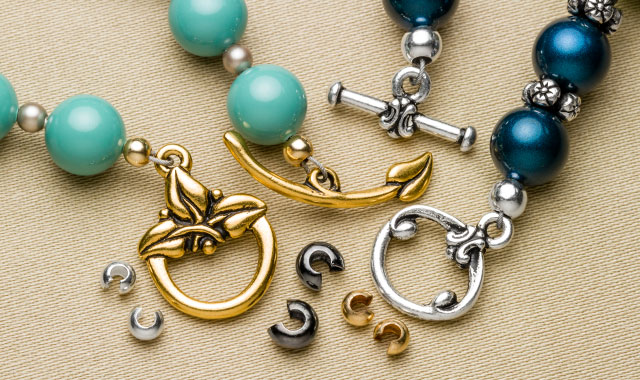All About Crimps

Crimps are designed to work with Jewelry Wire. If you are working with jewelry wire, it is more than likely you will work with crimps. These durable little findings will provide your designs with security and add professional finishing touches. Best of all, they are easy to use! When creating jewelry, you want the best findings for the project, so it's important to learn all about the crimps you will be using.
Crimps come in two different forms: as a bead or as a tube.

Crimp Beads:
Crimp beads are shaped like a hollow round bead and come in a variety of sizes and metals. To secure them to jewelry wire, flatten the crimp bead with a pair of flat or chain nose pliers. The flattened bead grips the jewelry wire. The image below shows what a crimp bead looks like when it is finished and crimped to wire. If done properly, the crimp bead will be very secure, but if the crimp bead is squeezed too hard it can break or at least be weakened and could fail over time as the jewelry item is worn. Over-squeezing can also bite into the jewelry wire itself, causing it to fray or break, which will also weaken the jewelry item. It just takes a little practice to get the feel of crimping and once you have it down it's easy to do!

Crimp Tubes:
Crimp tubes come in a variety of sizes and metals, too, and some even have patterns on them. To crimp them, you need a crimping tool. There are different sized crimping tools for the various sizes of crimp tubes: Micro for tiny crimp tubes and mighty for some larger sizes. Very large crimp tubes can be flattened with a pair of flat or chain nose pliers. There is also a magical crimping tool that will shape the crimp tube into a bead shape. The image below shows the three different sizes of crimp tools described.

Using Crimp Tubes:
To secure them to the jewelry wire, crimp the wire with a crimping tool. The tool has two stations. The first station puts a crimp in the crimp tube and the second station folds the crimped tube in half. The crimped and folded tube grips the jewelry wire. The image below shows what a crimp tube looks like when crimped to jewelry wire. The same rules apply here as well; if done properly, the crimp tube will be very secure. Over-squeezing can cause breakage of the crimp tube itself or the jewelry wire.

Crimp Sizes:
Using the right size crimp bead or tube is also very important. If the crimp is too large for the jewelry wire, it won’t be able to grip the wire properly and it could slip, causing the jewelry piece to fail. If the crimp is too small, particularly with crimp tubes, the jewelry wire won’t have room to separate for the crimp action and you won’t get a good fold.
So how do you choose the best size crimp for the job?
Most often, the jewelry wire in a design will pass through the crimp twice. Multiply the jewelry wire diameter by two (twice through the tube). Then choose a crimp with an inside diameter that is slightly larger than that number.
Crimp Covers:
Crimp covers are designed to fit over the crimped bead or tube. They look like a bead, so it gives the design a more finished look. You can learn more about using crimp covers with this tutorial.

You've learned about crimp tubes, crimp beads and crimp covers. Knowing the difference between these findings will help you in all of your jewelry-making endeavors, since they are almost always used when working with jewelry wire. If you would like to learn more about jewelry wire, see our Choosing Jewelry Wire page.
